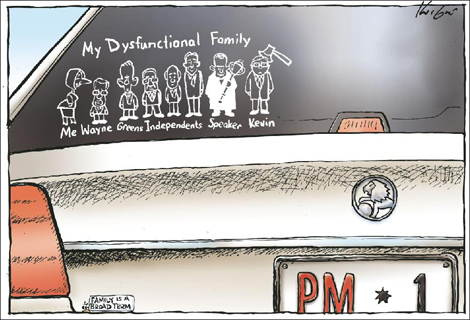From 04:30 to 20:30 makes it a long day and I start to feel my age, particularly when I’m required to walk any distance. I couldn’t lead my Battalion association in Brisbane because the old legs won’t last the distance at marching pace and as it took me so long to move anywhere I actually missed viewing the march as well.
Daughter chauffeured during the day and Son and his sons escorted me down to the reunion pub. The family pitch in to make it all possible and for one day of the year I stop being independent.
At the Dawn Service at the
National Memorial Walk, the Catafalque Party were actually an armed patrol, dressed in patrol order and when the party dismounted they moved in patrol formation checking their arcs and covering each other as they moved through the hundreds of trees – each tree representing a soldier of the Regiment who had died on active service. They moved until they became ghostly apparitions and then finally invisible in the pre-dawn light and they had this old soldier’s undivided attention.
I am the typical Army Officer, albeit long retired, and would be expected to insist on the maintenance of long held traditions. The
Catafalque Party has always been soldiers dressed in ceremonial Uniforms drilling as dictated to by the Army Drill Manual. The drill movements are difficult but significant, particularly the ‘Rest on the Arms Reverse’ as the linked DVA site mentions;
The origin of the tradition of resting on reversed arms is lost in time, however, it was used by a Commonwealth soldier at the execution of Charles I in 1649 (the soldier was, however, duly punished for his symbolic gesture towards the King’s death) and it is recorded that at the funeral for Marlborough, in 1722, the troops carried out a formal reverse arms drill, which was especially invented for the service, as a unique sign of respect to the great soldier.
The ‘modern trend’ of sticking rifles upside down into the ground as a temporary memorial to a fallen soldier (with a helmet or a hat over the butt) originated with the introduction of tanks. When a soldier fell during an advance his mate would pick up the rifle and stick it into the ground, by the bayonet, as a marker to indicate to the tanks that a wounded or dead soldier lay there; this way the armoured vehicle would not accidentally run over the body.
But as I watched spellbound, I thought what better guard than a new generation of professional soldiers in patrol formation – ready to fight.
The Party came from the Rear Details of the local battalion of the Royal Australian Regiment.
Rear Details is Army talk for those left behind in Australia while the rest of the Battalion serves in Afghanistan.
They were thinking of their mates and I was thinking of mine – a generational divide is joined by young men who would rather be overseas but who accept their lot and pay homage to soldiers that have gone before them.
Damn! They look young and fit. No problems with their legs – yet.
I met a lot of Afghanistan vets during the day and if anyone thinks they don’t want to be there they are deluding themselves. All the conversations of the ‘yet to go’ mob were about their chances of getting overseas before the Politicians pull the pin and the conversations of the ‘already been there” were their chances of getting back. Of the later group the most common expressed opinion was that they fully believed they had made a difference to the people of Afghanistan.
I spoke at length to a young recce Captain (I was recce myself so we had that in common) and he extolled the capabilities of the Afghanistan military. I was a little surprised but he was adamant. On the whole, they were good troops and hard when it mattered.
I believed him.
Talking to him it was plain that our defence force is in good hands and they are as good as we thought we were, if not better.
